Steel Seed Review – Stealth Platforming Done Right
I was delightfully surprised by Steel Seed. Coming off of a row of disappointing stealth mechanics and poor AI in games like Star Wars Outlaws (at launch) and Avowed, this action stealth platformer has been a breath of fresh air. And it makes sense why considering it’s developed by Hitman series alumni. It certainly feels like a higher budget game than it leads on, featuring crisp controls and environments that compelled me to stop and admire the details. I initially didn’t expect much, but was instantly hooked by the post-cataclysmic world and raw fun such an industrial environment provides in its level design. Armed with a neon sword and trusty turret droid at her side, Zoe platforms her way through a robot-strewn facility to restore her dad’s consciousness and help revive humanity in the process. Let’s explore what makes this premise so satisfying to engage with, shall we?
Having played plenty of indie games with lackluster stealth mechanics, I was surprised at just how satisfying the stealth is in this game. Steel Seed is Storm in a Teacup Studios’ first game, and yet the Hitman DNA seeps through this indie game’s veins providing refined stealth gameplay. Basic enemies have predictable patrol patterns, making it a frustration-free experience to sneak up and stealth kill them.
I particularly enjoy baiting enemies with a sound pulse as I hide behind cover only to take them out as they approach. Each enemy encounter you have in the game supplies you with plenty of obstacles to hide behind. There’s even patches of holographic grass that fully cloaks you when you’re crouched. You unlock an ability that remotely deploys these batches of holo grass later on which becomes particularly useful in densely populated zones. And what I like is how organic the areas manage to look despite the obvious gaminess here, and that’s thanks to the fantastic level design, which we’ll get into in a bit.
[embedded content]
“Patches of holographic grass cloaks your visibility when you’re crouched.”
Of course, stealth becomes broken and frustrating if the enemy AI isn’t adequate, and in this, Steel Seed doesn’t disappoint. Enemies catch you in their line of sight if you try rushing things, alerting others in the area of your presence. You can’t just crouch back in the grass or duck behind cover and hope enemies will immediately forget and retreat. They attack you until you completely leave the area or find a good enough hiding spot like a climbable tower above their heads. The smart enemy AI really compels the player to analyze the surrounding area for adequate hiding spots and evac routes in case things go wrong.
Thankfully, it’s easy to get a broad environmental mapping of any situation. Enemies have levels of alertness, with a red exclamation mark indicating pursuit and a yellow question mark prompting them to investigate. One of the main ways to avoid enemy patrols is marking them individually with Koby’s flight mode. You also unlock a patrol path marker ability later that shows each enemy’s specific patrol route.
To top things off, Koby can scan the environment for climbable ledges and hiding spots. You really do feel like Batman with all the intel at your disposal, and that’s mostly thanks to Koby. I also really like using Koby as a kind of shoulder turret. If you’ve played games with similar mechanics, you know how satisfying having your own ranged drone attacker is. Koby gets a number of skills throughout the game. Converting enemies to my side through the hacking skill in particular never gets old.
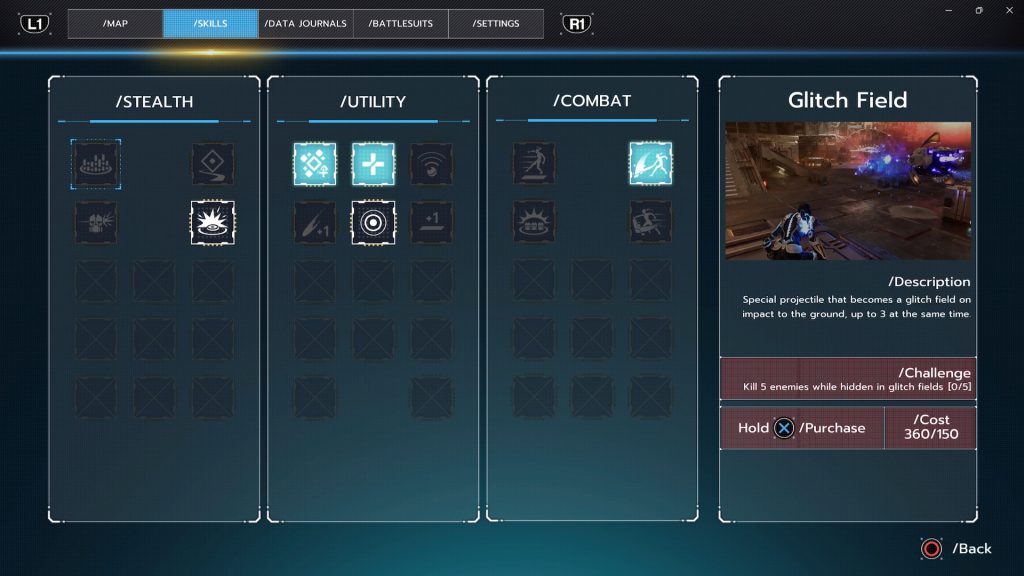
“Each skill has a prerequisite challenge checklist in order to unlock.”
Each skill has a prerequisite challenge checklist in order to unlock. Getting the Skull Piercer skill requires you to destroy 10 enemies’ weak points, for example. This is a neat way to reward skillful play and encourage exploration of the game’s various mechanics. There’s a bunch of other stealth tools at your disposal that get unlocked in the skill tree as well, so I won’t spoil them all here. But you don’t have to rely solely on your perception and stealth IQ in Steel Seed; close quarters combat is also a viable, though less enjoyable, option.
I didn’t find the combat as engaging or interesting as stealth. You’re equipped with a single neon-lit laser sword and of course your ranged drone companion Koby for turret cover. There’s no blocking or parrying in Steel Seed. Nor can you change or upgrade your weapon.
The game instead hones in on dodging and brute force. Perfect dodges are especially crucial considering the brutal amount of damage each hit sustains to Zoe. On the normal difficulty setting, two to three normal hits KO you. And with no block options, dodging is the only way to avoid getting steamrolled. Timing a perfect dodge rewards you with a follow-up heavy attack and some energy restoration, if you unlocked it on the skill tree.
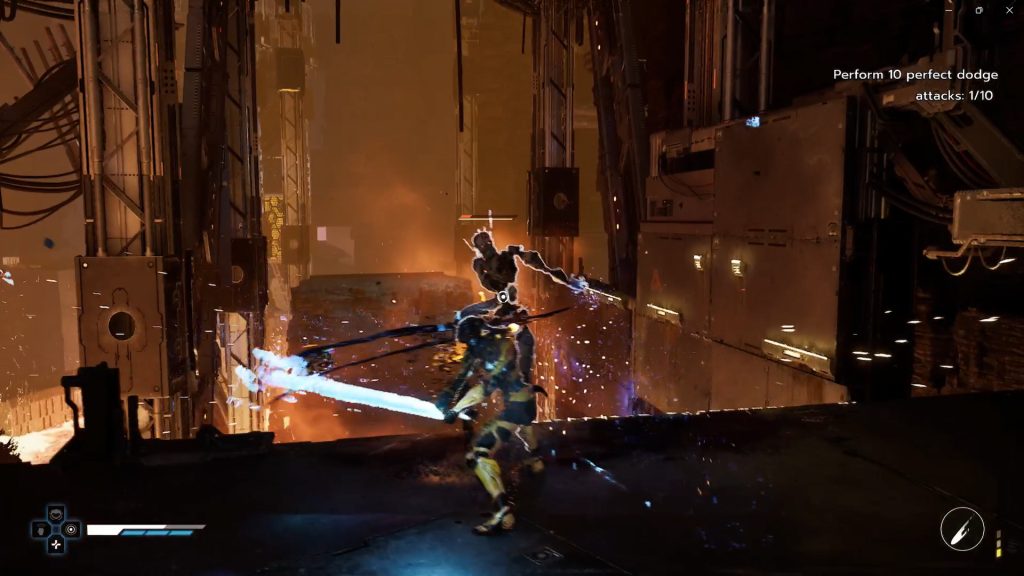
“There’s no blocking or parrying in Steel Seed.”
My main source of apathy regarding combat isn’t with controls or anything, but the limited amount of melee options. You have a light attack and strong attack, each with one combo, but you cannot string the two types together smoothly. There’s no light attack dash or light aerial slam attacks either, which further limits melee options.
At least the lock-on works well enough and the general movement feels responsive. While combat isn’t necessarily terrible, it does leave one wanting a bit more out of close encounters, especially since hits are incredibly punishing with little defensive kit to offset it. This is something that’s easy to look past considering the game’s enjoyable and varied stealth mechanics, but it’s still felt when caught up in those close quarters situations where there’s little else but well-timed dodges to fall back on.
Unfortunately, the foes you engage with aren’t any more interesting than your melee options. The game severely lacks in enemy variety. This first five hours has almost nothing but common patrol robots and it doesn’t get much more varied from there. There’s not too many boss fights in the game either, which I’m okay with considering the larger emphasis on stealth overshadowing pure melee encounters. It’s likely the small enemy variety is due in part to the intelligent AI given to each enemy type. They focused on quality and not quantity regarding enemy design, which I can appreciate to an extent.

“It’s a good thing the basic controls are as tight as they are since you’ll be platforming through a sizable portion of the game.”
Combat variety aside, Steel Seed is just plain fun to control. Movement is snappy and Zoe’s turn radius is razer sharp. She has a double jump that gets her parkouring across the terrain with a breeze. I do wish there was a mid-air dodge, but the slick slide-to-crouch and general dodge roll suffice well enough in most situations. I can’t even complain about the camera control, which was erratic pre-patch, but has since been greatly smoothed out with its own sensitivity settings. And it’s a good thing the basic controls are as tight as they are since you’ll be platforming through a sizable portion of the game.
3D platformers are among my favorite genres, and I’ve got to say I was surprised how well Steel Seed scratched that itch. I went in expecting a slow paced stealth game, but there’s plenty here to satisfy the parkour crowd too. The monolithic subterranean robot facility you’ll be adventuring through is a platforming paradise. It’s filled to the brim with balance beams, precarious platforms, deadly gaps, wall-run panels, and towering structures with everyone’s favorite yellow paint dotting climbable ledges.
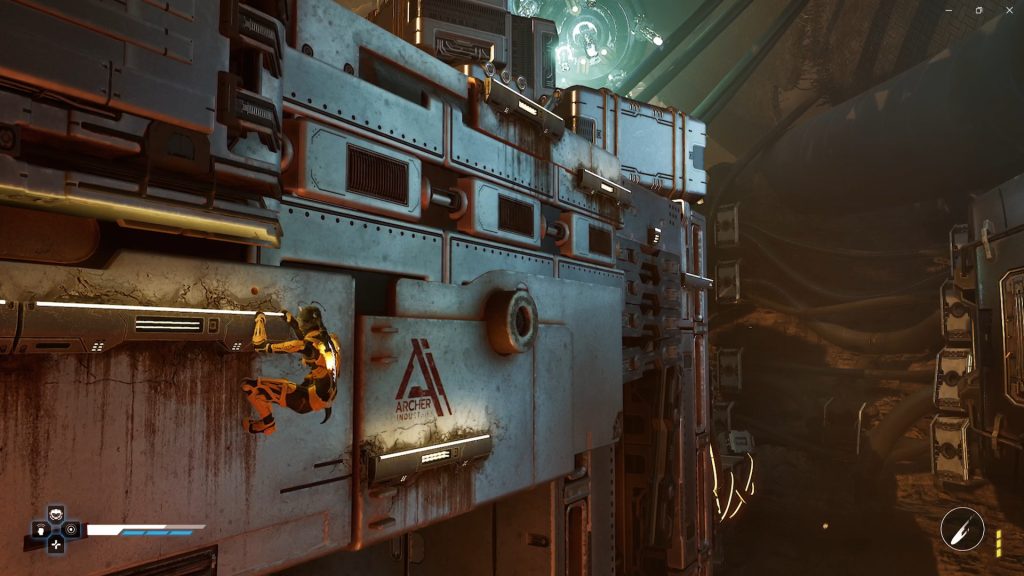
“Every area has unique visuals and challenges, providing a fresh experience all the way to the end.”
There’s a good amount of environmental storytelling throughout these platforming sections too. Each process of robot manufacturing gets explored in detail with refineries glowing with red heat and intricate caves housing dark secrets. Each environment dovetails into the next in an organic way too, making the large robotic facility feel all the more immersive to journey through. Something else that impresses me is the variety between environments. I never got fatigued by any repetitiveness at all (well, except in enemy variety); every area has unique visuals and challenges, providing a fresh experience all the way to the end. I thoroughly enjoyed the 3D platforming aspect of the game, so much so that it sits alongside the stealth as my favorite feature that Steel Seed exhibits. That brings me to the game’s overall structure and flow.
You see, Steel Seed isn’t strictly linear but it’s not open-world in its design either. You’re going to hate me for using the dreaded comparison, but it’s by far the closest I can think of. Steel Seed’s levels are structured in a Soulslike manner, Demon’s Souls in particular. Fast-travel checkpoints compartmentalize each of the large zones (or Nodes as the game terms it) into levels.
While there’s very little of the classic looping design from Soulslikes here, there’s plenty of secrets off the beaten path with some branching areas here and there. The fast-travel stations, called S4VI or Savi, restore health in return for respawning the area’s enemies. It’s also here where you unlock skills and save the game. The game does autosave as you go, but your only manual option is at these S4VI stations. Oh, and fast travel stations indicate the completion percentage for each level, giving completionists even more incentive to scour every nook and cranny. I found the gameplay loop of platforming and stealthing my way from one S4VI station to the next to be quite addicting and fun.
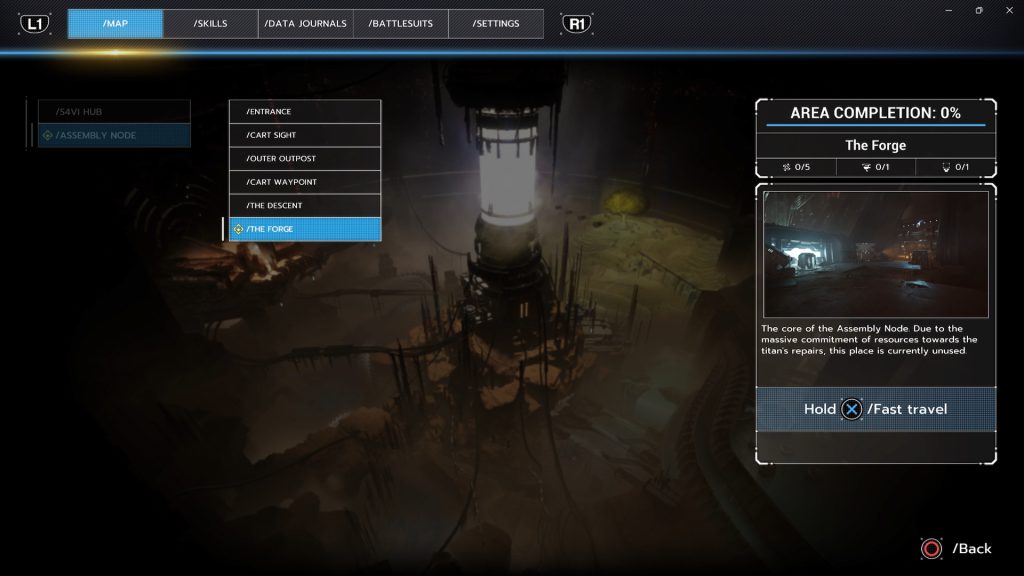
“Fast travel stations indicate the completion percentage for each level, giving completionists even more incentive to scour every nook and cranny.”
There’s also a hub area that you return to after retrieving each game’s major plot shards. Interestingly enough, the hub is home to a piano minigame. If you’ve played Final Fantasy VII Rebirth, you’ll instantly recognize the interface and function as it’s practically identical. Although there’s no sheet music to play to, you can play basic melodies using scales and chords and even alter the pitch range. Currently, the chords don’t show notation for anything outside of basic major and minor harmonies, and the F note is always sharped for some reason, but it’s a cool music minigame nonetheless.
Anyway, once you’re done tinkering the ivories, you’ll notice that the hub acts as the home for a majority of the game’s plot and progression. Your core objective throughout the game is retrieving four shards to bring your dad, and the future of humanity, back from a devastating cataclysm. While the hub provides a lot of the core plot progression, there’s more to be found through exploration. Data journals are scattered across levels helping shed more light on the massive facility and its history.
Being that this is a post-cataclysmic setting, there’s not a ton of plot advancement throughout the game. You’re retrieving the four McGuffins to save humanity and that’s largely the gist of it. I appreciate the simplistic plot device because the game does a good job filling out the background lore of Zoe’s scientist dad and his managing of the facility well. And despite being a post-cataclysm, the journey doesn’t feel totally silent or lonely either. Zoe and her droid companion banter and interact throughout the game in an endearing way that didn’t grate or irritate me.
The voice acting is good across the board and never felt out of place or overdone either. From a gameplay perspective though, the forced walking sequences during exposition and character reactions slow things down to a crawl, and the real bummer? There’s no way to skip them. I’d much rather have traditional skippable cutscenes than unskippable slow walk sequences, especially since many of them are placed right before a tough battle or parkour sequence where reloads are sure to occur due to a mistake or five.
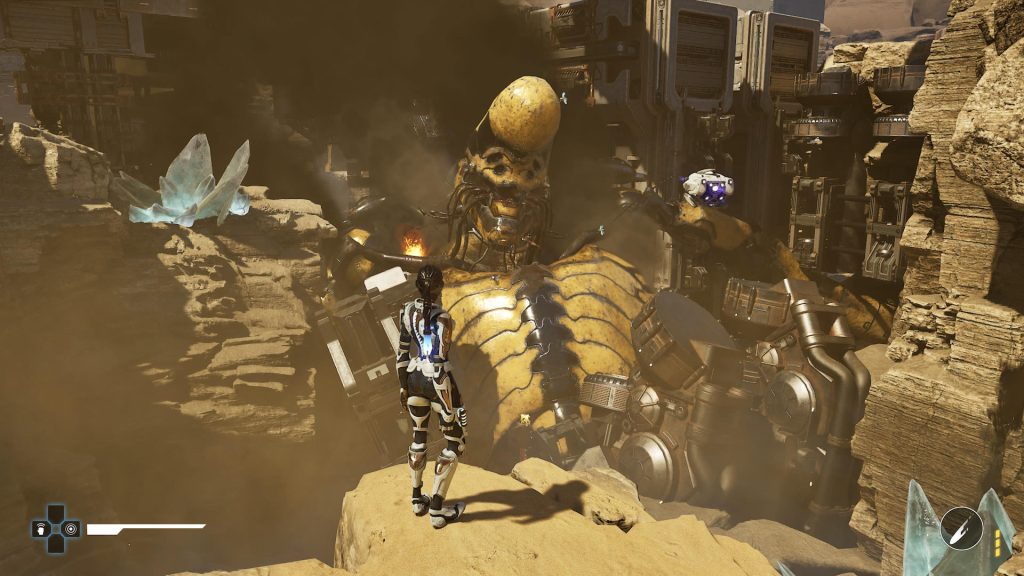
“The forced walking sequences during exposition and character reactions slow things down to a crawl.”
I’ve got to say, I’m thoroughly surprised by Steel Seed. It’s a very competent stealth action platformer from a new indie studio. The atmosphere and level design is awe-inspiring at times and the moment to moment action feels great thanks to responsive controls and fun stealth mechanics. More melee options would’ve helped vary the gameplay up a lot, but it’s serviceable as is. If you’re looking to scratch that stealth action itch, or someone who’s desperately clinging to anything resembling 3D platforming collectathons, like me, Steel Seed comes highly recommended.
This game was reviewed on the PlayStation 5.


Comments are closed.